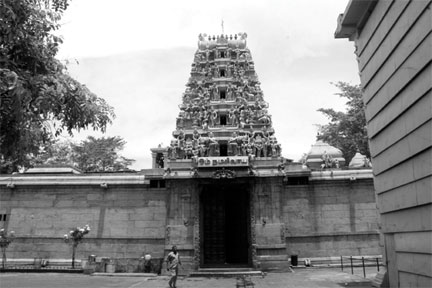Chariot festival of Sri Ponnambalavaneswarar temple
by Chelvathamby MANICCAVASAGAR
Kochchikade Sri Ponnambalavaneswarar temple's annual festival
commenced on March 27. The Chariot festival will be held on April 4 and
the water-cutting ceremony on the following day at Sri Swarna Pushkarani
Theertha Thadakam followed by “Poongavanam” on April 6. D M Swaminathan,
chief trustee of the temple has made elaborate arrangements for the
festival.
 The temple was built by Sri Ponnambala Mudaliyar in 1857. He was the
father of Sir Ponnambalam Ramanathan, a great patriot who sacrifice his
life for the independence of Sri Lanka. After the death of Sri
Ponnambala Mudaliyar the temple was managed by Sri Kumaraswamy Mudaliyar
and thereafter by Sir Ponnambalam Ramanathan. The temple was built by Sri Ponnambala Mudaliyar in 1857. He was the
father of Sir Ponnambalam Ramanathan, a great patriot who sacrifice his
life for the independence of Sri Lanka. After the death of Sri
Ponnambala Mudaliyar the temple was managed by Sri Kumaraswamy Mudaliyar
and thereafter by Sir Ponnambalam Ramanathan.
Sir Ponnambalam Ramanathan got down several sculptors and architects
from South India and rebuilt the temple.
In the temple there are two Rajayopusams for Lord Siva and Goddess
Ambal and the entire walls and pillars are constructed using granite.
The poojas are conducted six times daily. “Kanthashesty”,
“Thiruvenbavai” and “Navarathri Vizha” are held regularly.
Lord Siva, performs five-fold functions, namely creation maintenance,
destruction and purification. He is said to be preforming all the
functions during his cosmic dance. The most auspicious occasion for the
worship of Lord Siva is the Maha Sivarathri day in February-March.
On this night Lord Siva reveals Himself from a Lingam in a flame of
light. Other special occasions are Prathosam days twice every month. In
general all Mondays and Fridays are auspicious to pay reverence to Siva
Murthy.
Hindu temples are intended to instruct man in the art of removing the
veil of attachment that covers his heart. Thus, the renowned poet
Thiyagarajah cried in the temple at “Thirupathi” to remove the veil of
attachment pride and hatred. Hindu temples are meant for the testing of
value of life and the awakening of divinity in humanity inducing men to
believe that the physical frame in which they live is the house of God.
In Hinduism the Supreme Lord is represented by “Lord Siva” and His power
is represented by His consort “Goddess Parvathy”.
During the Chariot or Ther festivals several devotees from all parts
of Colombo will congregate in large numbers to participate in the
festival. When the Chariot carved out of pure silver and laden with gold
deities, studded with diamonds and rubies more slowly from the temple,
it symbolises peace, communal harmony and eternal prosperity.
The “Chariot” symbolises the human body and the statue of Lord Siva
is the soul. In front of the Chariot are the wooden horses depicted as
galloping and the reins are attached to their mouths and held in the
hands of the image of Lord Siva.
The horses represent human passions and the reins symbolise the
necessity of restraining and guiding the passions.
The journey of the Chariot through the streets symbolises the
progress of life. This shows that throughout his life a man must control
and guide his passions. Their passions are the motive powers, the
driving force of life, but unstrained and unguided they will wreck a
man's life. This is the symbolic meaning of Chariot or Ther festival.
|

